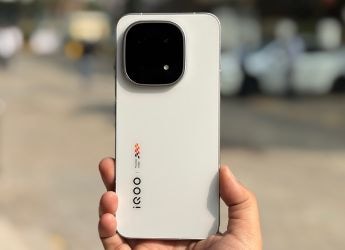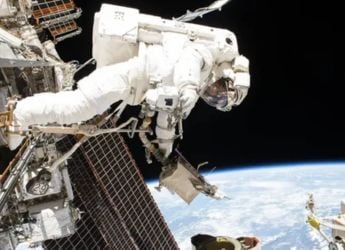- Home
- Chandrayaan
- Chandrayaan News
- Chandrayaan 3 to Launch on July 14, Soft Landing Expected on August 23 or 24
Chandrayaan-3 to Launch on July 14, Soft Landing Expected on August 23 or 24
Chandrayaan-3 is a follow-on mission to Chandrayaan-2 to demonstrate end-to-end capability in safe landing and roving on the lunar surface.

Chandrayaan-3 mission life of the lander is one lunar day, which is equal to 14 Earth days
The Indian Space Research Organisation announced on Thursday that the Chandrayaan-3 mission is scheduled to be launched at 2.35 pm on July 14, with the lander expected to soft-land on the surface of the Moon on August 23 or 24.
Chandrayaan-3 is a follow-on mission to Chandrayaan-2 to demonstrate end-to-end capability in safe landing and roving on the lunar surface.
The Chandrayaan-3 spacecraft, which will be launched by LVM3 (Launch Vehicle Mark-III) (earlier referred as GSLV Mk III), is a composite of three modules -- propulsion, lander, and rover (which is housed inside the lander).
"LVM3-M4/Chandrayaan-3 Mission:The launch is now scheduled for July 14, 2023, at 2:35 pm IST from SDSC, Sriharikota", the national space agency headquartered here said in a tweet.
Secretary of the Department of Space and ISRO Chairman Somanath S told reporters that the space agency would attempt soft-landing of the lander on August 23 or August 24.
ISRO officials noted that the mission life of the lander is one lunar day, which is equal to 14 Earth days.
"The date (for soft-landing) is decided based on when there is sunrise on the Moon. While landing, sunlight must be there. There is sunlight on the Moon for 14-15 days and for the next 14-15 days there is no sunlight," they noted.
Chandrayaan-3 mission carries scientific instruments to study the thermo-physical properties of the lunar regolith, lunar seismicity, lunar surface plasma environment and elemental composition in the vicinity of the landing site.
While the scope of these scientific instruments on the lander and the rover would fit in the theme of "Science of the Moon", another experimental instrument will study the spectro-polarimetric signatures of the Earth from the lunar orbit, which would fit in the theme of "Science from the Moon", according to ISRO officials.'.
In March this year, the Chandrayaan-3 spacecraft successfully completed the essential tests that validated its capability to withstand the harsh vibration and acoustic environment that the spacecraft would encounter during its launch.
The propulsion module, which has Spectro-polarimetry of Habitable Planet Earth (SHAPE) payload to study the spectral and polarimetric measurements of Earth from the lunar orbit, will carry the lander and rover configuration till 100 km of lunar orbit.
Lander payloads are: 'Chandra's Surface Thermophysical Experiment' to measure the thermal conductivity and temperature; 'Instrument for Lunar Seismic Activity' for measuring the seismicity around the landing site; and 'Langmuir Probe' to estimate the plasma density and its variations.
A passive Laser Retroreflector Array from the US space agency, National Aeronautics and Space Administration (NASA), is also accommodated for lunar laser ranging studies.
Rover payloads are: 'Alpha Particle X-ray Spectrometer' and 'Laser Induced Breakdown Spectroscopy' for deriving the elemental composition in the vicinity of the landing site.
The lander will have the capability to soft-land at a specified lunar site and deploy the rover which will carry out in-situ chemical analysis of the lunar surface during the course of its mobility.
The main function of the propulsion module is to carry the lander module from launch vehicle injection till final lunar 100 km circular polar orbit and separate it. Apart from this, the propulsion module also has one scientific payload as a value addition which will be operated post separation of the lander module, it was noted.
Catch the latest from the Consumer Electronics Show on Gadgets 360, at our CES 2026 hub.
Related Stories
- Samsung Galaxy Unpacked 2025
- ChatGPT
- Redmi Note 14 Pro+
- iPhone 16
- Apple Vision Pro
- Oneplus 12
- OnePlus Nord CE 3 Lite 5G
- iPhone 13
- Xiaomi 14 Pro
- Oppo Find N3
- Tecno Spark Go (2023)
- Realme V30
- Best Phones Under 25000
- Samsung Galaxy S24 Series
- Cryptocurrency
- iQoo 12
- Samsung Galaxy S24 Ultra
- Giottus
- Samsung Galaxy Z Flip 5
- Apple 'Scary Fast'
- Housefull 5
- GoPro Hero 12 Black Review
- Invincible Season 2
- JioGlass
- HD Ready TV
- Laptop Under 50000
- Smartwatch Under 10000
- Latest Mobile Phones
- Compare Phones
- OnePlus Turbo 6V
- OnePlus Turbo 6
- Itel Zeno 20 Max
- OPPO Reno 15 Pro Mini 5G
- Poco M8 Pro 5G
- Motorola Signature
- Vivo Y50e 5G
- Vivo Y50s 5G
- Lenovo Yoga Slim 7x (2025)
- Lenovo Yoga Slim 7a
- Realme Pad 3
- OPPO Pad Air 5
- Xiaomi Watch 5
- Huawei Watch 10th Anniversary Edition
- Acerpure Nitro Z Series 100-inch QLED TV
- Samsung 43 Inch LED Ultra HD (4K) Smart TV (UA43UE81AFULXL)
- Asus ROG Ally
- Nintendo Switch Lite
- Haier 1.6 Ton 5 Star Inverter Split AC (HSU19G-MZAID5BN-INV)
- Haier 1.6 Ton 5 Star Inverter Split AC (HSU19G-MZAIM5BN-INV)

















